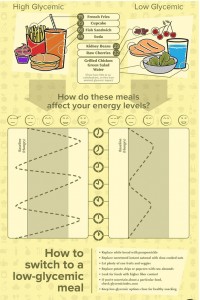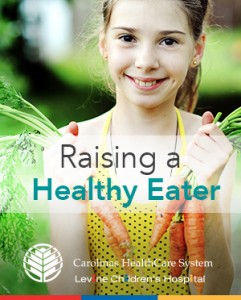 This is the first in a series we’re working on with Levine Children’s Hospital as part of their Healthy Together initiative, a healthy lifestyles campaign with Carolina Panthers quarterback Cam Newton. First up, we asked Dr. Ana-Maria Temple, pediatrician at Charlotte Pediatric Clinic, for ideas on how to convey the importance of healthy eating to kids – especially tweens and teens. She’s got GREAT advice. Enjoy!
This is the first in a series we’re working on with Levine Children’s Hospital as part of their Healthy Together initiative, a healthy lifestyles campaign with Carolina Panthers quarterback Cam Newton. First up, we asked Dr. Ana-Maria Temple, pediatrician at Charlotte Pediatric Clinic, for ideas on how to convey the importance of healthy eating to kids – especially tweens and teens. She’s got GREAT advice. Enjoy!
As adults, we know that healthy eating leads to a better quality of life, but our kids don’t always understand the connection. What are some ways we can get this idea engrained in our kids and teens?
In my office, I come across this question frequently. I talk to the kids specifically about how food affects their body. Examples for the elementary kids are: chips/soda/sports drinks/cookies can make us tired, hungry, cranky, and slow at recess. Fruits/vegetables/water can make us smart so we know the answers in class, strong so no one takes our toys, and most importantly super-fast so no one can catch us on the playground (this catches their attention every time).
With the teens I keep it simple – doughnuts, soda, and junk help feed your acne. Sugar is an acne fertilizer. So if you indulge regularly, you’ll have to spend a lot of money and time on lotions and potions to clear your skin. Bagels/waffles/juice are delicious but can make you tired all day and can cause headaches, bad skin and trouble focusing.
As a healthcare professional, what are some of the most successful “marketing” tactics you’ve used for selling healthy eating to a big kid or teen?
A. In our office we have posted a picture of popular cereals with sugar packets hanging down from the bowls to indicate how much sugar is in each highlighted cereal. We did the same for juice/coffees/sports drinks/soda.
B. I give them the Sugar Packet Homework – go home, take the juice box out of the lunch box, find sugar grams on the label, divide sugar grams by 3, and that number will equal the number of sugar packets in the drink. Have the kids tape all the sugar packets to the drink in question and message sent. This is a very powerful visual for all.
C. I give them the Highlighter Homework – Kids who eat pre-packaged lunches have to go home, find the pre-packaged box, find the ingredient list. Then they have to take a highlighter and highlight all the words they know. The deal is, if they know half the ingredients then they can keep on eating this stuff. If they have no idea what the ingredient list means that indicates that it’s not too healthy and they should find an alternative that contains more nutrition. This has been a very successful approach and I have had numerous kids come back to say that they will never ever eat pre-packaged lunches again. The ones who keep up the habit did not do the homework.
D. I draw graphs of energy levels based on food eaten for the tired teens – this visual is simple and makes so much sense to teens, it works wonders.

If a big kid or teen takes responsibility for their own healthy eating habits, it’s sure to be more successful. Do you have any tips for parents on how to instill this responsibility in their child?
First I make sure they do the homework above.
Second, I ask parents to take kids food shopping with them and have kids help in the produce aisle. Furthermore, I encourage all parents to have kids help in the kitchen. Many studies show that kids who help in the kitchen eat more fruits and veggies then kids who just get served. Kids can help with washing fruits/veggies, peeling carrots/cucumbers/potatoes (age appropriate), help with making salad by cutting/tossing/arranging veggies. At many ages they can help by taking broccoli/cauliflower apart and mixing it with olive oil and other seasonings (yes they can use their clean hands to mix, forego the utensils), placing these veggies on baking tray. They can help make smoothies of various combinations, and it’s ok if some are gross and only some are good. The fun is in the experiment and empowerment.
Third, if parents want to instill good habits and responsibility they must lead the way by example. Parents have to stop buying and drinking soda/juice/sports drinks. Parents need to eat fruits/veggies/proteins/complex carbs. There is no need for junk to be in the house. Kids do not listen well to what we say, but they follow everything they see!!
My teenage daughter is currently borderline on her pediatrician check-up (100th percentile in weight, 50th percentile in height). What tips do you have for our conversations about healthy lifestyle and food choices, but I don’t want her to feel like she’s “fat”. As we all know, this can stick with her for life and cause long-term psychological problems.
Check-ups begin with height and weight and BMI and this can be very stressful for a lot of families. However, it’s not about being fat, it’s about being unhealthy. Unhealthy leads to diabetes. Diabetes is super hard to manage and very expensive. Together we look at the weight and height and then we FOCUS on change. Each person can and is willing to change one thing, and we must zone-in on that. Not a thousand things, but ONE thing. Then together we discuss how as a family and as a medical team we can help the teen achieve that one change. Most teens have great ideas on how to make a change, but they need accountability and partnership from the family and doctors to make that change. Examples, parents need to stop buying soda/juice/sports drinks so the teen is not tempted. (These are addicting substances and willpower is not enough). A parent can stop drinking diet soda, stop smoking, start cooking at home more, start going to the gym to form a partnership with the teen. Teens are very receptive to having the parent make a change with them, and this way they are not singled out, but it becomes a team challenge.
Thank you so much to Dr. Temple for sharing your ideas with us.
![]()
More from Levine Children’s Center on their Healthy Together initiative
Healthy habits are important for the whole family. For a smart game plan to get you there, follow 5-2-1-0. Every day, eat at least 5 servings of fruits and vegetables, limit screen time from TVs, video games, smartphones and other devices to 2 hours or less, get at least 1 hour of physical activity, and aim for 0 sugary drinks, drinking water or low-fat milk instead. To learn more about 5-2-1-0, access fun health tips and activities, and pledge to be healthy together with your family. Take the pledge and join the 5-2-1-0 League of healthy families in our community!
![]()
Dr. Ana-Maria Temple
Charlotte Pediatric Clinic
Levine Children’s Hospital
Facebook
Instagram
Twitter
Pinterest





